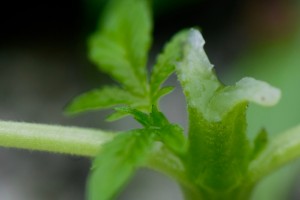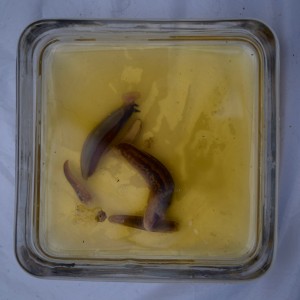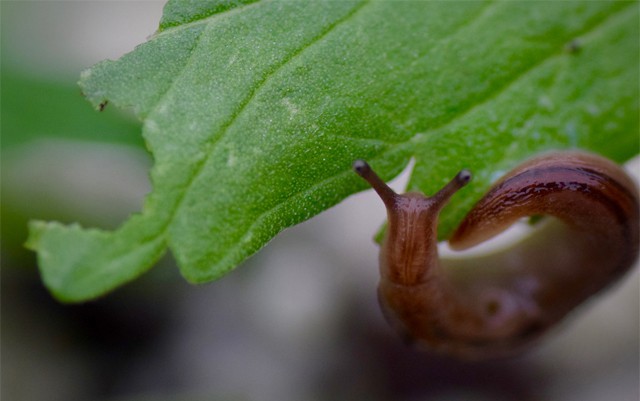Slugs can be devastating to your cannabis garden, especially when the plants are young and tender. They are a particularly nasty threat in outdoor and greenhouse grows, and in cool and wet regions where they strike at night.

Slugs lay their eggs in soil and dark, cool places. The ravenous baby slugs emerge during the evening and devour pretty much anything green in sight. They then skulk away to their dark, cool hiding places during the day to preserve moisture. I know, icky isn’t it?
Once your cannabis plants harden and the stems are more woody, you should be in the safe zone with regards to these shell-less terrestrial gastropod molluscs.
Generalist vegetarians
Slugs are not very picky with what vegetation they will eat, which means gardeners of therapeutic herbs should be on guard. The baby slugs seem to eat more than the larger adults and unfortunately, they are not as enticed to bait and traps as the big guys.
As for eating your friendly cannabis plant, they munch on the leaves and can even fell a seedling entering vegetative growth. This is something that happened to me once on a month-old plant in the greenhouse.
They are most active after a rain, thanks to the moist ground. So pay attention to your garden after rains whilst your plants are starting their vegetative growth.
They are hermaphrodites, so any two of the same species can breed. A few days after breeding, they then lay 30 eggs. Which is why it’s important to destroy every slug that you encounter in or near your garden.
Slug fest
There are many poisons available on the market, but these should be avoided on your substrate itself as it will permeate the soil and stay there well beyond the duration of the grow. Not the kind of thing you would like to be consuming as medicine.
Slugs have natural predators; frogs and toads being the most likely to live in or near your garden. There is a big old toad who lives a short hop from my greenhouse called “El Toado”. When I find a slug I tend to chuck it his way to save me from creating the snotty mess that comes from crushing it under my boot.
Know your foe
They are a real headache to get rid of and can kill plants in one session, so a surprise attack can be costly. You need a defensive and offensive strategy to beat these slimy little blighters. It really helps to get to know your enemy’s weaknesses so you can strike where it’ll hurt the most.
As we know, they like to hide during the day. The first thing to do is make sure that they have limited places to hang out in. Remove everything from the garden that is not essential for the grow. The less clutter in your grow space, the less places for slugs to hide and for you to monitor.
Jorge Cervantes, in his seminal tome the Cannabis Encyclopaedia, suggests making a “slug hotel”. Get a board of wood and put some little feet on it to raise it up a half inch (2 cm) from the ground. Check it each day and kill the inhabitants with your preferred method. You may feel bad about killing them, at first, but if you are unfortunate enough to see what they do to your plants, you’ll no doubt relish enacting your revenge or acting in a pre-emptive fashion.
Slugs are mostly water so they pop quite easily with the scrape of a shoe on a rough surface. I have heard of people chopping them up with scissors, which seems a bit too sadistic for my liking. Though I’ve seen enough of their destruction to see where people who do this are coming from.
I did whack one with the edge of a trowel once and sliced it in two. A couple more swift blows and it’d been quartered. It was like Fruit Ninja, but with slugs.
A slug’s sensitive side
The next step to take is to make sure they don’t get to the plants at all. Slugs have a sensitive side. In fact, it is the soft underside that we can use to our advantage.
Sharp sand is something that they will not slide over. Make a 2-3 inch barrier (5-10 cm) of sharp sand or gravel around your plants. I make a layer under and around the pots whilst the plants are susceptible to attack. The theory is that it will make a barrier they cannot cross. The sand I used was not sharp enough and the slugs glided over it with ease, so go for the really sharp stuff if you can get ahold of it. Then, do as I did and find a slug to test on your barrier to see if it actually stops them.
Slug balls
Perlite stops them in their tracks too. Add a half inch (1-2 cm) layer of perlite above the surface of your substrate as a double barrier.
I tested a slug’s ability to cross perlite. Within a second it was covered in the white, light volcanic rocks and was immobilized — creating what looked like a snowball with a soft slug centre.
The slug’s response to the perlite is defensive; secrete a slimy mucous and roll in a ball. This may work when confronted with some predators, but on perlite this sticky goo leaves our slimy adversary in a bit of a pickle. Like I said, know your foe.
Another measure you can take is to put a propagation dome over your plant as it hardens off (assuming you are germinating them indoors under lights or even on the windowsill). You leave this on until you are confident it is strong enough to withstand an onslaught of incoming slugs. A cloche like this has other benefits than just protecting your baby plants from pests. Outdoors or in greenhouses, it will maintain high humidity and temperatures which will reduce shock and encourage the plant to root out in the pot faster. When I run AutoPots, I use propagation domes which fit snugly onto the pot and have a vent for you to gradually harden your plant off before removing the dome when the leaves are up against the top and sides.
A slug pub
The above steps should help protect your plants from the hungry, smaller young slugs. For the larger adults, you can catch them in slug traps. A popular method is to make a “slug pub”.

Put a shallow dish of beer out where you know slugs are lurking. The marauding night crawlers cannot resist the smell of a nice beer. I use organic but I don’t suppose they mind. As one gulp kills them they don’t get the chance to become a beer snob like me.
After one sip they tumble into the deadly slug pub where they fall and drown to death in beer. A fitting end for those hell bent on destroying your cannabis garden. And a stark reminder of the slippery slope of alcohol abuse.
Night watch
One final tactic, if you fancy hanging out in your garden or greenhouse at night. You can ambush them at dusk or in the cover of darkness with a flashlight and pick them up as they meander around your cannabis patch. You can then destroy them with your preferred method — maybe chucking them in the “slug pub” for one final deadly drink of mead.







leaving your plants (of any kind) under the dome after germination is a common mistake. You are setting yourself up for mold, Powdery mildew, and damping off fungal diseases by exposing to high humidity early in growth. SOIL TEMP and Ambient temp are more important factors to speed growth, NOT humidity. The dome should come off ASAP after the seeds have germinated. Where did you learn that anyway? Bro science book? You are putting out BAD and INCORRECT growing INFO
You are making it harder than it needs to be by creating problems due to lack of proper knowledge.